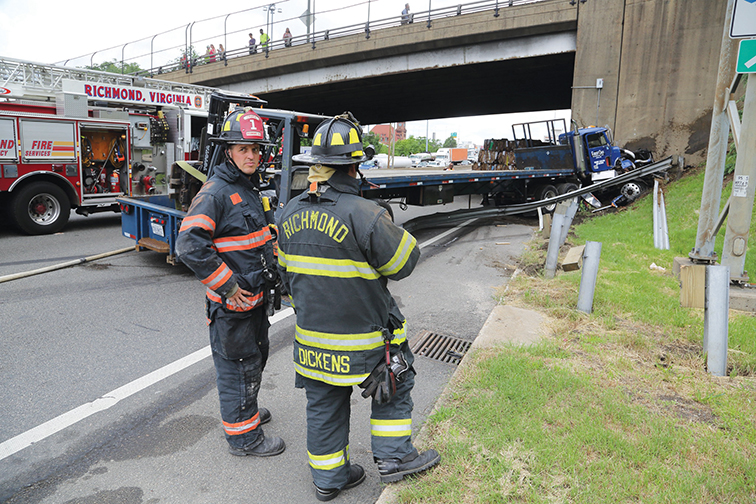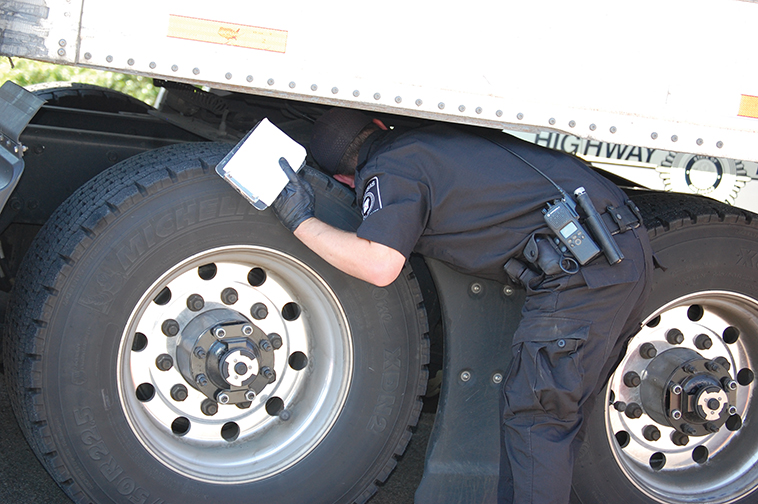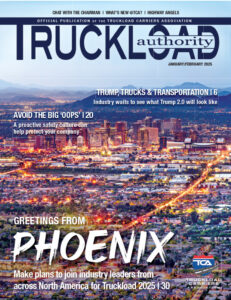Despite the change in administrations and the fact that there is no clarity about where President Joe Biden and Transportation Secretary Pete Buttigieg stand on current and proposed rules and regulations, the Federal Motor Carrier Safety Administration has continued to move forward by naming a driver advisory committee, proposing a pilot program to study further flexibility in the hours-of-service rule, and issuing a final rule that will streamline the CDL procurement process by allowing third-party testers to provide applicants with both skills training and skills testing.
FMCSA ASSEMBLES ADVISORY PANEL OF 25 COMMERCIAL DRIVERS
The U.S. Department of Transportation’s Federal Motor Carrier Safety Administration (FMCSA) has named 25 commercial motor vehicle (CMV) drivers from all sectors of the industry to serve as a new panel to the agency’s Motor Carrier Safety Advisory Committee (MCSAC).
“FMCSA believes in listening to our drivers and hearing their concerns directly,” said then-FMCSA Deputy Administrator Wiley Deck. “We know that many of the solutions to the challenges we face don’t come from Washington — they come from the hard-working men and women who are behind the wheel all over our nation. This new subcommittee to MCSAC will further help us hear from America’s commercial drivers.”
This new panel, led by the Owner-Operator Independent Drivers Association (OOIDA) President Todd Spencer, will provide direct feedback to FMCSA on important issues facing the driving community — such as safety, hours-of-service regulations, training, parking, and driver experience. This new panel is comprised of 25 drivers from all sectors of the CMV industry, including tractor-trailer drivers, straight-truck drivers, motorcoach drivers, hazardous-materials drivers, agriculture haulers, and more.
According to a statement from FMCSA, the agency wants to hear directly from commercial drivers and then incorporate their opinions and concerns into FMCSA’s safety initiatives.
The panelists include:
- Todd Spencer, OOIDA — Chair;
- William Bennett III, UPS Freight;
- Teddy Cranford, Waste Management of Maryland Inc.;
- Debra Desiderato, Walkabout Transport;
- Douglas Feathers, URS Midwest Inc.;
- Steve Fields, YRC Freight;
- JoAnne Forbes, MBT Worldwide Inc.;
- Gerald Fritts Jr., American Overland Freight;
- John Grosvenor, McKiernan Trucking;
- Attila Gyorfi, RSP Express Inc.;
- W. Scott Harrison, K Limited Carriers;
- Rhonda Hartman, Old Dominion Freight Lines;
- Darwin Hershberger; Hershberger Livestock LLC;
- Daniel Kobussen, Kobussen Buses Ltd.;
- Deb Labree, Castle Transport LLC;
- Alphonso Lewis, YRC Freight;
- Don Logan, FedEx Freight;
- Kellylynn McLaughlin, Schneider National Inc.;
- Tina Peterson, Ravenwood Transport;
- Stephen Pryor, Greyhound Lines Inc.;
- H. Kevin (Brandy) Russell, Transport America;
- Douglas Smith, Ralph Smith Co.;
- Kevin Steichen, Steichen Trucking;
- Angelique Temple, Atlantic Bulk Carrier; and
- Desirée Wood, Real Women in Trucking.
FMCSA PROPOSES NEW SLEEPER-BERTH PILOT PROGRAM
The Federal Motor Carrier Safety Administration (FMCSA) has announced a new proposed pilot program for commercial motor vehicle (CMV) drivers to evaluate two additional options for splitting sleeper berth periods — a 6/4 split and a 5/5 split.
“FMCSA continues to explore ways to provide flexibility for drivers, while maintaining safety on our roadways,” said then-FMCSA Deputy Administrator Wiley Deck. “This proposed pilot program will provide needed data and feedback for the agency to use now and in the future. Gathering more data on split-sleeper flexibility will benefit all CMV stakeholders. We encourage everyone to review this proposal and provide their public comments.”
During the proposed pilot program, participating drivers would have the option to split their 10 hours of sleeper berth time into two periods — as long as each of the two periods is at least four hours, and the combined time of the two periods equals at least 10 hours. Drivers participating in the program would also be free to choose whether to operate under the exemption based on their schedule. Carriers and drivers desiring to participate would apply to FMCSA for acceptance in the pilot program.
As part of its rulemaking process on hours-of-service reform, FMCSA asked for public input regarding potential split periods of 6/4 or 5/5 to gather data on the two options. The agency did not receive any additional data during the comment period; this pilot program would help provide empirical data on potential split sleeper periods.
According to a statement from FMCSA, the agency has worked closely with motor carrier stakeholders on the issue of sleeper berth periods. Both motor carriers and organized labor have supported efforts to explore additional options. The International Brotherhood of Teamsters stated that “the majority of Teamster team drivers … indicated they preferred having more flexibility in the time that they can obtain restorative rest periods.”
INSPECTOR GENERAL: FMCSA FALLS SHORT IN OVERSIGHT OF REGISTRY OF MEDICAL-CERTIFICATION EXAMINERS
A report released in January by the U.S. Department of Transportation’s (DOT) Office of Inspector General revealed that the Federal Motor Carrier Safety Administration (FMCSA) has fallen short in meeting oversight requirements while rebuilding the National Registry of Certified Medical Examiners.

As part of its mission, the FMCSA oversees its medical-certification program and promotes safety through regulations, policies, and monitoring of certified medical examiners and driver examinations. The purpose of the National Registry of Certified Medical Examiners, initiated in 2014, is to verify that medical examiners can effectively determine if interstate commercial drivers meet FMCSA’s physical qualification standards.
In 2019, as fatalities in crashes involving large trucks or buses increased by 10.6% over a five-year period, an audit of FMCSA’s oversight was initiated due to the significant safety risk posed by drivers who do not meet physical qualification requirements. The audit analyzed FMCSA’s procedures in validating and maintaining data quality in the registry and monitoring medical examiner eligibility and performance and reviewing driver examinations.
“FMCSA’s ability to oversee whether drivers meet physical qualification standards to safely operate a commercial vehicle is limited because of a lengthy outage of the National Registry and a resulting backlog of driver examination reports that were not entered into the Registry,” the Office of Inspector General noted in a January 13 statement. The report also notes that the effectiveness of FMCSA’s oversight is hampered by data that is not fully accurate or complete.
“FMCSA has not fully implemented requirements for random periodic monitoring of medical examiners’ eligibility and performance,” the statement continued. Initial certification reviews have been conducted to verify medical examiners’ eligibility, but FMCSA has not implemented annual audits. These periodic audits could result in the FMCSA missing fraud indicators or other risks.
FMCSA has been advised of the following recommendations following the audit:
- Implement Agency plans for eliminating the backlog of driver examination results held by medical examiners;
- Develop a plan to allocate resources to the Medical Programs Division to fully implement requirements for medical examiner eligibility audits and random selection performance monitoring;
- Update Agency processes for conducting periodic medical examiner eligibility audits and random selection performance monitoring as needed to incorporate upgraded National Registry tools; and
- Reinstate the conduct of eligibility audits and random selection performance monitoring of medical examiners.
According to the January 13 statement, FMCSA concurs with these recommendations to improve oversight of the National Registry of Certified Medical Examiners.
FMCSA ISSUES FINAL RULE STREAMLINING CDL SKILLS TESTING
The Federal Motor Carrier Safety Administration (FMCSA) has issued a final rule to streamline the process for men and women interested in entering the trucking industry. The new rule will allow states to permit a third-party skills test examiner to administer the commercial driver’s license (CDL) skills test to applicants for whom the examiner also provided skills training.
“During the COVID-19 public health emergency, truckers have been American heroes — and the department is committed to helping our economy by reducing unnecessary barriers for those interested in obtaining jobs in the trucking industry,” said then-Secretary of Transportation Elaine Chao.
Federal rules previously prohibited a third-party CDL skills instructor who is also authorized by the state to administer the CDL-skills test from performing both the instruction and the qualifying testing for the same CDL applicant. The final rule, announced in mid-December, eliminates that restriction, and permits states, at their discretion, to allow qualified third-party skills trainers to also conduct the skills testing for the same individual. This new rule is designed to alleviate testing delays and eliminate needless inconvenience and expense to the CDL applicant without compromising safety.
“Under Secretary Chao’s leadership, the Trump administration has continued to examine ways to provide common-sense regulatory reform and help individuals seeking to enter the commercial driver industry,” shared then-FMCSA Deputy Administrator Wiley Deck. “This new rule will provide states more flexibility during the ongoing public health emergency to test CDL applicants and allow more drivers to safely enter the industry.”
DOL ISSUES FINAL RULE CLARIFYING DEFINITION OF ‘INDEPENDENT CONTRACTOR’
The Department of Labor (DOL) published a final rule in the Federal Register that clarifies the standard for employee versus independent contractor status under the Fair Labor Standards Act (FLSA).
The rule defines “independent contractors” as people who are, in fact, in business for themselves and are not economically dependent on a single potential employer for work.
“This rule brings long-needed clarity for American workers and employers,” said then-U.S. Secretary of Labor Eugene Scalia. “Sharpening the test to determine who is an independent contractor under the Fair Labor Standards Act makes it easier to identify employees covered by the act, while recognizing and respecting the entrepreneurial spirit of workers who choose to pursue the freedom associated with being an independent contractor.”
The final rule includes the following clarifications:
- Reaffirms an “economic reality” test to determine whether an individual is in business for him or herself (independent contractor) or is economically dependent on a potential employer for work (FLSA
employee. - Identifies and explains two “core factors” that are most probative to the question of whether a worker is economically dependent on someone else’s business or is in business for him or herself, notably (1) the nature and degree of control over the work, and (2) the worker’s opportunity for profit or loss based on initiative and/or investment.
- Identifies three other factors that may serve as additional guideposts in the analysis, particularly when the two core factors do not point to the same classification. The factors are (1) the amount of skill required for the work, (2) the degree of permanence of the working relationship between the worker and the potential employer, and (3) whether the work is part of an integrated unit of production. The actual practice of the worker and the potential employer is more relevant than what may be contractually or theoretically possible.
- Provides six fact-specific examples applying the factors.
The Biden administration is expected to pause the implementation of this final rule for further review. The rule could also fall victim to being overturned by the newly Democratic Congress.
In mid-January, the DOL’s Wage and Hour Division released an opinion letter clarifying that motor carrier safety requirements for owner-operator drivers do not affect independent contractor status.
The opinion letter, which came after a request from American Trucking Associations, specifically asks the DOL to allow motor carriers to provide or require various types of safety training and safety equipment to drivers without endangering their status as independent contractors.
This opinion letter, along with several others, was later withdrawn by the Biden administration. The Wage and Hour Division noted the letters were, “issued prematurely because they are based on rules that have not gone into effect.”
NEW ADMINISTRATION CAN REVERSE SOME FINAL RULES
Almost buried in the flurry of news surrounding President Joe Biden’s infrastructure plans is the Congressional Review Act (CRA) that empowers Congress to review, by means of an expedited legislative process, new federal regulations issued by government agencies and, by passage of a joint resolution, to overrule a regulation. Once a rule is thus repealed, the CRA also prohibits the reissuing of the rule in substantially the same form or the issuing of a new rule that is substantially the same.
The law, passed in 1996, had been invoked only once before former President Donald Trump and the Republican Congress used it 16 times to repeal Obama-era rules.
Final rules released in the last 60 legislative days of the previous Congress are impacted. For the current session of Congress, that date is August 11, 2020.
According to George Washington University’s (GWU) Regulatory Studies Center, just short of 1,400 federal regulations fall within that 60-day legislative window. Of that number, 319 come from the Department of Transportation (DOT) — the most of any department.
GWU said 224 “significant” rulemakings are on the list; DOT leads with 33.
Truckload Carriers Association Vice President of Government Affairs David Heller said one rule that is on the list from the Federal Motor Carrier Safety Administration (FMCSA) is a final rule clarifying agricultural commodity and livestock definitions in hours-of-service (HOS) regulations.
One piece of rulemaking from the Department of Labor (DOL) on the list that impacts trucking is a final rule that clarifies the standard for employee versus independent contractor status under the Fair Labor Standards Act (FLSA). The rule defines “independent contractors” as people who are in fact in business for themselves and are not economically dependent on a single potential employer for work.
A final FMCSA rule to streamline the process for men and women interested in entering the trucking workforce was issued during the time, but it was not published in the Federal Register during the last 60 days of the previous session. Thus, the rule is not subject to the CRA but will instead receive internal review at DOT before it moves forward. The rule will allow states to permit a third-party skills test examiner to administer the Commercial Driver’s License (CDL) skills test to applicants to whom the examiner has also provided skills training.
FMCSA and other agencies have other rulemakings in various stages.
“A new administration will not take action through the CRA against anything other than a final rule,” said Heller. “Rather, a new administration simply won’t move forward in the rulemaking process.”
GHSA CALLS UPTICK IN TRAFFIC FATALITIES ‘TROUBLING’
The Governors Highway Safety Association (GHSA) said that an uptick in traffic fatalities during the third quarter of 2020, despite a decline in vehicle miles traveled (VMT), is a “troubling trend” as traffic volumes return to normal, according to an article published by The Journal, the official publication of the American Association of State Highway and Transportation Officials.
Early estimates issued by the National Highway Traffic Safety Administration (NHTSA) indicate that 11,260 people died on U.S. roadways in the third quarter of 2020, which is a 13.1% increase compared to the same period in 2019.

Throughout the first nine months of 2020, NHTSA’s early data indicates that 28,190 people died in motor vehicle crashes — a 4.6% increase compared to the first nine months of 2019.
Meanwhile, Federal Highway Administration data shows that VMT during the first nine months of 2020 dropped by about 355.5 billion miles or about 14.5%, meaning the fatality rate for the first three quarters of 2020 jumped to 1.35 fatalities per 100 million VMT. That number is up from 1.10 fatalities per 100 million VMT over the same period in 2019.
“We can’t afford to compound the staggering loss of life from COVID-19 with additional preventable deaths caused by unsafe driving behaviors like speeding, driving under the influence or distracted, and not wearing a seat belt,” noted GHSA’s Executive Director Jonathan Adkins in a statement.
“The vaccine for unsafe driving is available to every American right now — slow down, buckle up, stow your phone, and never drive impaired,” he said. “If we don’t inoculate ourselves against these dangerous driving habits, a lasting impact of this pandemic will be even more traffic deaths — an unacceptable outcome.”
CVSA ANNUAL ROADCHECK SCHEDULED FOR MAY 4-6
The Commercial Vehicle Safety Alliance (CVSA) has announced this year’s International Roadcheck dates — May 4-6.
Over this 72-hour period, commercial motor vehicle inspectors in jurisdictions throughout Canada, Mexico, and the U.S. will conduct inspections on commercial motor vehicles and drivers.
“CVSA shares the dates of International Roadcheck in advance to remind motor carriers and drivers of the importance of proactive vehicle maintenance and driver readiness,” said CVSA President Sgt. John Samis of the Delaware State Police. “International Roadcheck also aims to raise awareness of the North American Standard Inspection Program and the essential highway safety rules and regulations in place to keep our roadways safe.”
Inspectors will ensure the vehicle’s brake systems, cargo securement, coupling devices, driveline/driveshaft components, driver’s seat, exhaust systems, frames, fuel systems, lighting devices, steering mechanisms, suspensions, tires, van and open-top trailer bodies, wheels, rims, hubs, and windshield wipers are compliant with regulations. Inspections of motorcoaches, passenger vans, and other passenger-carrying vehicles also include emergency exits, electrical cables and systems in the engine and battery compartments, and seating.

Inspectors will be looking for critical vehicle inspection item violations, outlined in the North American Standard Out-of-Service Criteria. If such violations are found, the vehicle will be placed out of service, which means that vehicle cannot be operated until the identified out-of-service conditions have been corrected.
Also during an inspection, inspectors will check the driver’s operating credentials, hours-of-service documentation, seat belt usage, and for alcohol and/or drug impairment. A driver will be placed out of service if an inspector discovers driver-related out-of-service conditions.
Each year, CVSA asks its member jurisdictions to capture and report data focusing on a certain category of violations during International Roadcheck. This helps bring awareness to certain aspects of a roadside inspection. This year inspectors will capture data on two categories, corresponding to the two main inspection categories of the North American Standard Level I Inspection — driver operating requirements and vehicle mechanical fitness. For the driver category, hours of service will be highlighted this year, and for the vehicle category, inspectors will be paying special attention to lighting.
As was the case last year, in consideration of COVID-19, law-enforcement personnel will conduct inspections following their departments’ health and safety protocols during 2021 International Roadcheck.
Last year, more than 50,000 inspections were conducted. The overall vehicle out-of-service rate in North America, for Level I, II and V Inspections combined, was 20.9%.
The top two categories for violations were brake system with 3,163 violations (25.8%) and tires with 2,326 violations (19%).
Because of the pandemic, last year’s International Roadcheck was held in September.
The Truckload Authority News Staff, comprised of award winning journalists and graphic artists, produces content for Truckload Authority, working in cooperation with the Truckload Carriers Association staff. Truckload Authority aims to keep TCA members abreast on the latest trends in the trucking industry as well as articles that feature TCA member executives and drivers. The Truckload Authority staff is based in Little Rock, Arkansas.








